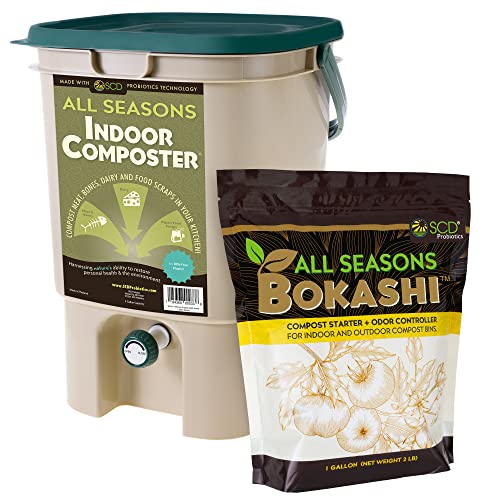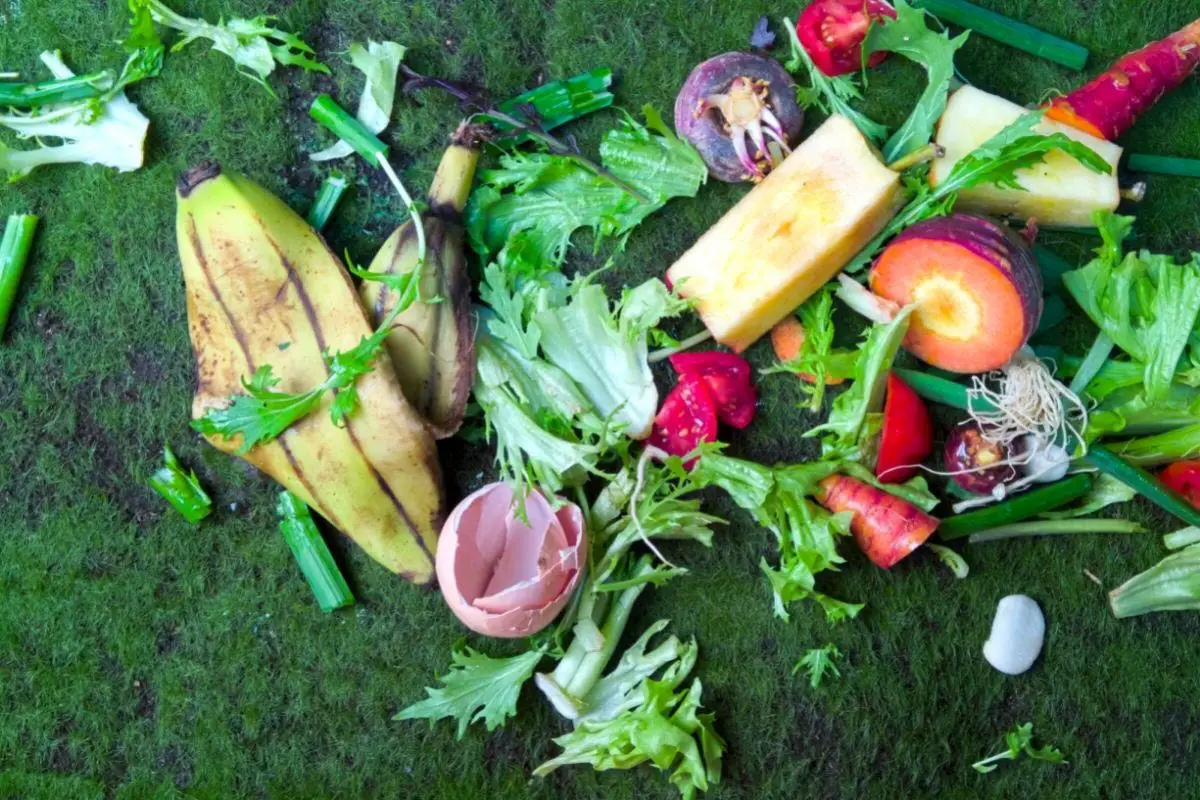Best Bokashi Bucket (Top 4): Turn Kitchen Scraps into Fertilizer!
Bokashi Composting is becoming more and more popular – for good reasons. It is an easy way to divert food scraps from landfills and it is suitable for people living in small spaces and those with no gardens. So, what is the best Bokashi bucket?
My personal favorite is the Bokashi Living Starter Kit which is a ‘everything-you-need’ type of set, but there are other great options depending on your budget, size of your family and available space.

In this article, we also address the benefits of Bokashi compared to traditional composting and what to consider when buying a Bokashi bucket!
Best Overall – Bokashi Living Starter Kit

Bokashi Living Starter Kit is no doubt my personal favorite as it has everything you need to be successful in your Bokashi composting journey. It comes with two buckets that you can alternate.
The advantages of having two buckets are well documented: when bucket 1 is full, you can start using bucket 2 while bucket 1 gets extra time for fermenting your scraps undisturbed. Bokashi Living Starter Kit also comes with 2 packets of bran – which you add to your food waste to get the fermentation process going. The super tight lid keeps the smell and the insects away. The lid is one of the most durable on the market, and the company offers replacement parts.
Pros
- All-you-need-included
- Quality tight lid and tap – keeping smell and insects away
- Replacement parts available
Cons
- More expensive – as it comes with ‘everything’ you need
Best Bokashi for Beginner – SDC Probiotics Store Indoor Composter

If you are new to compost and/or unsure about the Bokashi method, it is unlikely that you will want to invest in a double-bucket system straight away – I certainly didn’t. When I started, I only bought one bin and went on to buy my second bin when I felt confident I was going to stick to it. So, my recommendation, for a not-very-experienced beginner, is for a single bin plus bran (or spray).
The SDC Probiotics Store has a great Bokashi kit comprising of a 5 gallon Bokashi bucket and a pack of bran. Alternatively, you can choose the Bokashi bucket and spray combination. Personally, I had better results with the bran, however the spray is ‘smaller’ if space is an issue. SDC Probiotics Indoor Composter offers the option of black or beige color.
Pros
- Smaller initial investment
- Choice of Bokashi Bran or spray
Cons
- If you decide to get a second bucket, it is more expensive than going for the double bucket system
Best Small Bokashi Bucket – Exaco Urban Composter

There aren’t many 2-gallon bins on the market, but this one from Urban Composter from Exaco is a perfect small alternative. Most Bokashi buckets come in standard 5-gallon capacity size, but if you live in a small house (with a small kitchen) or an apartment, or you are a small family with very little food waste, a 5-gallon bucket can be quite bulky, and it may take ages for it to fill up. A 2-gallon Bokashi bucket is a great small bucket alternative.
Pros
- Smaller bucket for small families or small spaces
- Cheaper than most bigger Bokashi bins
Cons
- Not recommended for a big family
Best Budget Bucket – DIY Bokashi Bucket
I love a good DIY project, and you can easily make a Bokashi system by getting two same size buckets piled up – one of them with a tightly fitted lid. You will need to drill drainage holes to the ‘internal’ bucket where food scraps go and you use the external bucket to catch ‘the juice’. Bokashi bran or spray is still needed for the fermentation to happen. From time to time, you empty the juices out of the external bucket either into the garden or down the sink.
You could get more sophisticated and put a spigot in the external lid, but then the project starts to get more complicated and more expensive! Personally, if I had a couple of spare buckets sitting around and was curious to try Bokashi composting, I would try this. However, there are limitations compared to a system specifically designed for Bokashi composting – particularly, the lid (and possible spigot) that let smells and insects in and out!
Pros
- Can be very cheap if you have the required materials
Cons
- Design might not keep smell and insects away
What are the benefits of Bokashi vs traditional compost?
The first thing to bear in mind is that Bokashi is a two-step system.
After your food scraps ferment in your Bokashi bucket, they need to either be buried or be transferred to a traditional compost bin for further composting before you can spread that in your garden.
So, what is the point of Bokashi if I need further composting?
That was one of my first questions when I heard of Bokashi? Well, there are good benefits of going through this 2-step process.
1 . With a Bokashi bucket, you can dispose of your food scraps directly on your kitchen bench and it can stay there for weeks. With traditional composting, I had to do pretty much day-trips to take my waste to the compost bin outside.
2. The fermented food waste will turn into compost much faster than non-fermented food scraps.
3. With Bokashi, I throw away pretty much any food waste including citrus, meat, bread, etc. These are items not usually recommended for traditional composting – and they often end up in your garbage bin. However, the fermentation process breaks them down and makes it safe for them to go into the compost bin, reducing the amount of trash in your general bin.
4. Many people do not have a garden or enough space for a traditional compost bin. With a Bokashi bucket, you can collect your food scraps and when the bin is full you can take it to a community garden or to someone who is happy to share their compost bin with you.
What to consider when buying a Bokashi bucket?
Tightness!
A good tightly sealed container is a must for keeping bad smells and insects out of your house. Apart from that, it also means that oxygen will not easily get into your Bokashi bucket – facilitating the anaerobic fermentation process.
Replacement lid and spigot
Even the most robust lids and spigots can break after prolonged usage. The availability of replacement parts is one of the reasons why I love Bokashi Living buckets.
Size
For a family of five like mine, there is no point going for anything smaller than a 5 gallon bucket.
Bran vs Spray
I had better results with the bran – for me, the white mould – which is a good sign, as opposed to green mould – seemed to be thicker and quicker to develop. But no doubt the spray is smaller and easier to find room to put away.
Does Bokashi smell bad?
A tightly sealed Bokashi bucket should not smell. When I open my bucket, a strong acidic smell inundates the kitchen! I will be honest here – I don’t think it is a pleasant smell, but it is only there when I open the Bokashi bucket to put food scraps in or when I let the juices out. Once the lid is on and the tap is tightly closed, I can forget about it.
If the smell persists when the lid is on, it could be a sign that air is going in and out – due to your bucket not being tightly sealed or the quality of the bucket is poor. Also, your Bokashi should not smell like rotten food. If that is the case, you may need to add more bran.
Final Thoughts
When food scraps end up in open-air landfills, they produce methane – a greenhouse gas much more powerful than carbon dioxide. Diverting this kind of waste through a compost system is an important step towards reducing your carbon footprint and living a more sustainable life.
Last update on 2024-04-09 / Affiliate links / Images from Amazon Product Advertising API





